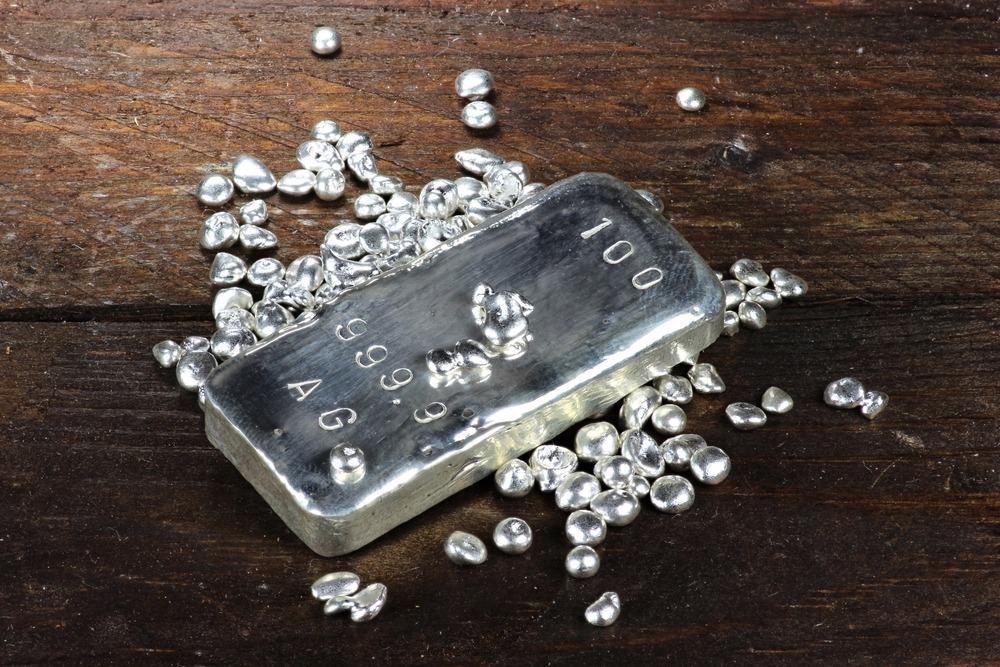 By Surbhi JainReviewed by Susha Cheriyedath, M.Sc.Apr 14 2022
By Surbhi JainReviewed by Susha Cheriyedath, M.Sc.Apr 14 2022In an article recently published in the journal ACS Applied Polymer Materials, researchers presented the absorption characteristics of poly(N-phenylglycine) membrane on silver (Ag(I)) as well as its application in practical silver recycling.

Study: Adsorption Studies on Ag(I) Using Poly(N-phenylglycine) Membrane and Application in Practical Silver Recycling. Image Credit: Bjoern Wylezich/Shutterstock.com
Background
Silver finds numerous applications in the aquatic system due to its diverse applications; however, the hazard this poses to humans and the environment has garnered increased attention. Silver, like many other metals, has been shown to trigger contact allergy reactions in sensitive people, making it a possible poisoning threat. The majority of the recoverable reserves of silver have already been used, and the remaining reserves are expected to be depleted by 2240; so, recycling must be stressed to keep the silver supply sustainable.
Because of the environmental and economic benefits, treating the Ag(I)-containing wastewater and recovering silver has become a study priority. Adsorption is a popular method for treating solutions having low Ag(I) concentrations. Because of their various functional groups, broad active surfaces, and other features, conductive polymers are considered effective adsorbents.
Another form of conducting polymer is poly(N-phenylglycine) (PNPG), which has conjugated skeleton-like polyaniline (PANI) but also contains numerous carboxylic acid groups that act as adsorption sites, making it a suitable candidate for water treatment. The selective adsorption of Ag+ must be investigated due to the presence of numerous Pb2+, Cu2+, and several other metal cations in the leaching solutions of discarded printed circuit boards (PCBs) as well as wastewater.
About the Study
In this study, the authors discussed the vacuum filtration of a PNPG membrane, and corresponding characterization studies were conducted to determine the reaction mechanism between the PNPG membrane and Ag (I). The adsorption of silver ions was investigated using non-deprotonated PNPG, to minimize the undifferentiated attraction of -COO- to cations.
The researchers placed PNPG onto an ester membrane of mixed cellulose using vacuum filtering. Characterization and adsorption tests were used to investigate the mechanisms of interaction between Ag(I) and the PNPG membrane. Municipal solid waste incineration (MSWI) fly ash and leaching solutions of waste PCBs were also tested for silver recovery.
The team used Fourier transform infrared (FTIR) analysis to determine the functional groups of the raw PNPG and NPG monomer. Scanning electron microscopy (SEM) at a 5 kV accelerating voltage in conjunction with energy-dispersive X-ray spectroscopy was used to examine the characteristics of the PNPG membrane surface.
An ICPE-9000 device was used to measure the ion concentrations. With 1 mmol L-1 KCl as an electrolyte, Zeta Plus was used to assess the zeta potential. The elemental composition of the MSWI fly ash was promptly analyzed using an X-ray fluorescence analyzer.
Observations
According to the results of the quantitative elemental analysis of processed MSWI fly ash, CaO accounted for the greatest quantity i.e., 37.87% in the sample, followed by Zn at 10.02% and Ag at 0.08%. The adsorption efficiencies of the waste PCBs leaching solution with a pH drop of 7 was maximum for Ag at 93.03%, followed by Cu at 15.88%, Pb at 6.04%, and Zn at 0.5%. PCBs contained 0.12% silver, which was greater than that found in natural argentiferous ore.
The adsorption efficiency dropped to 90% by the end of the fifth adsorption process. Pseudo-second-order model (PSO) fitting yielded an equilibrium adsorption capacity of 238.7 mg g-1, which was close to the experimental value of 229.5 mg g-1. The percentage of post-adsorption neutral benzenoid diamine in the sample dropped from 73.3% to 67.8%.
The proposed adsorption process followed the pseudo-second-order and Langmuir models, which suggested chemical adsorption and monolayer adsorption, based on studies on adsorption kinetics, pH effect, and adsorption isotherms. At pH 6, the PNPG membrane's maximum Ag(I) adsorption capacity was 366 mg g-1.
More from AZoM: What is Femtosecond Laser-Based 3D Printing?
According to the adsorption trials, Ag adsorption performance was greatly dependent on pH and was best under neutral conditions. The kinetic findings indicated that the adsorption process matched the PSO model well, which confirmed chemical adsorption. The results of the adsorption isotherm were in good agreement with the Langmuir model, which demonstrated monolayer adsorption. The theoretically calculated qm value of 366 mg g-1 was also close to the observed qm value. The PNPG membrane was able to adsorb more than 90% of the Ag ions.
Conclusions
In conclusion, this study elucidated the synthesis of a PNPG membrane after generating PNPG by polymerizing the NPG monomer using vacuum filtering. Silver ions could be absorbed by the PNPG membrane. The reaction mechanism of the PNPG membrane with Ag(I) was revealed by different characterization studies.
The majority of the redox reactions occurred between the neutral benzenoid diamine of PNPG and Ag(I) to generate a positively charged conjugative bipolaron and elemental silver. Coordination reactions occurred between Ag(I) and the lone-pair electrons of benzenoid diamine.
The authors emphasized that when leaching solutions of e-waste and municipal solid waste incinerator fly ash were exposed to adsorption studies, the PNPG membrane showed promise for recovering Ag from actual solutions. They mentioned that the PNPG membrane could be used to recycle silver in the future. Overall, they believe that the revelation of the mechanism by which the PNPG membrane interacts with silver ions has widened the application of this specific conductive polymer in adsorption research.
Disclaimer: The views expressed here are those of the author expressed in their private capacity and do not necessarily represent the views of AZoM.com Limited T/A AZoNetwork the owner and operator of this website. This disclaimer forms part of the Terms and conditions of use of this website.
Source:
Wu, T., Lin, Z., Wu, H., et al. Adsorption Studies on Ag(I) Using Poly(N-phenylglycine) Membrane and Application in Practical Silver Recycling. ACS Applied Polymer Materials (2022). https://pubs.acs.org/doi/10.1021/acsapm.1c01901.